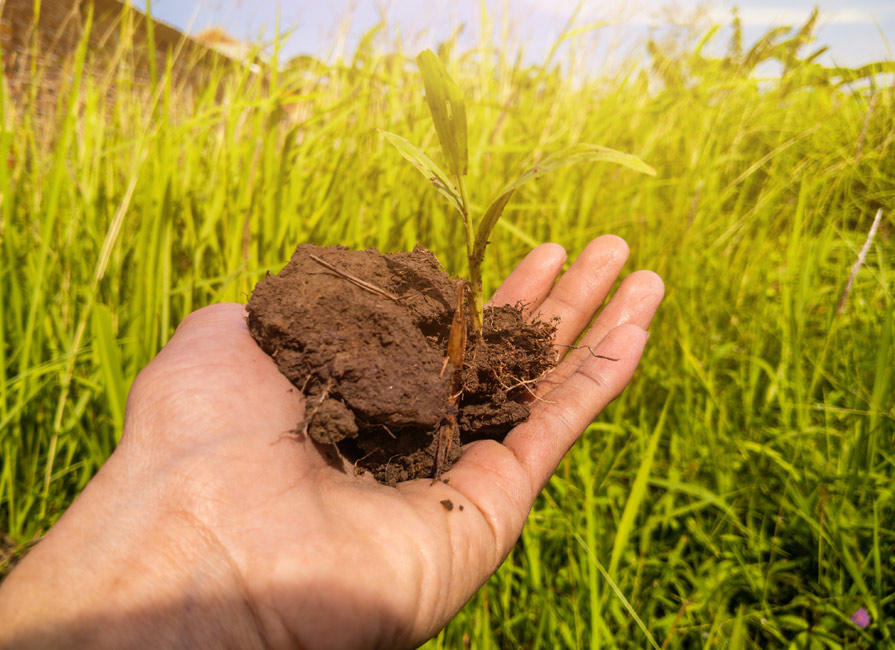Water is arguably the most important nutrient on earth. It is “the universal solvent,” providing…

Digging For A Gold Standard
It is generally accepted that increasing the amount of organic carbon in soil is beneficial for soil health and helps to remove CO2 from the atmosphere. But while soil carbon is a key component of evaluating the health of soil, it doesn’t encompass the totality of soil health. It is just one of the three indicators of soil health recommended by the Soil Health Institute (SHI).
There is also overlap between the role of soil carbon in soil health and its importance in the context of carbon storage, carbon sequestration, and carbon markets. To understand how soil carbon relates to soil health—and the distinction between soil health and soil carbon in other contexts—we first need to explore what soil carbon is, how to quantify soil carbon, and what causes changes in soil carbon.
What is soil carbon?
Soil carbon can exist in either organic or inorganic forms.
- Soil organic carbon comprises the complex mixture of molecules dominated by plant litter partially decomposed by microbial activity, as well as root exudates and microbial waste products, and the micro-organisms themselves. Basically, this includes anything that is or used to be part of a living organism. The vast majority of soil organic carbon is solid and non-living, but a small fraction is dissolved in the soil solution or within living microbes.
- Inorganic forms of carbon in soil, such as carbonates, can either exist in soils because the bedrock contains carbonates (for example, limestone or dolomite) or because carbonates form in the soils of drier regions.
How to quantify soil carbon
The current gold standard for quantifying soil carbon is by dry combustion of soil samples in a laboratory.
A soil sample is collected from the field and a small subsample is combusted at high temperature to convert all the soil carbon to carbon dioxide, which is then measured precisely. If inorganic carbon is present in the form of soil carbonates, a separate analysis must be done, and the inorganic carbon is subtracted from the total carbon to calculate soil organic carbon.
Several promising methods have the potential to make dry combustion obsolete and bring down associated costs (including the reflectance of different wavelengths of light to measure soil organic carbon in the field, in the lab, or even with remote sensing), while computer models calibrated with dry combustion measurements are getting better at predicting soil carbon based on the soil type and management. However, the dry combustion method is the current recommended measurement for soil organic carbon.
Why soil carbon varies over time and space
Based on the vast number of soil samples collected globally, we know that climate, vegetation, landscape position, parent material, soil texture, and disturbance history all affect the current concentration of soil organic carbon.
In general, soils with more clay will have more soil organic carbon, as a result of greater water holding capacity to grow plants and adsorption of organic carbon to clay surfaces, as well as physical protection within aggregates. However, based on land use history, the current amount of soil carbon will vary from the predictions, and the interpretation of soil organic carbon measurements will depend on the location. For example, a soil organic carbon concentration of 1% in the top six inches of one soil type might represent above average carbon because of good management, while in another soil type, this could represent a soil organic carbon concentration well below the average for that soil.
Soil organic carbon is also not a static quantity over time. It represents the balance between the inputs of organic carbon, mostly from photosynthesis by plants, and exports of organic carbon, mostly through crop removal and respiration by soil microbes. Microbial respiration converts the soil organic carbon back into carbon dioxide in the atmosphere.
Soil health generally focuses on the soil organic carbon concentration (reported as % carbon) in the top six inches of soil. In contrast, soil carbon markets are based on the sequestration of carbon in soil to greater depth. Carbon sequestration indicates that there has been a change in carbon storage or the total mass of soil organic carbon in the soil profile, usually to a depth of 12 inches.
This accounts for any redistribution of carbon throughout the plow layer from tillage. In some soils, especially artificially drained soils, the carbon is often still in a state of re-equilibrating.
How management affects soil carbon
Changing the inputs of carbon or the conditions for soil microbes can result in changing the amount of soil organic carbon. The most prominent example of this is conversion of native vegetation to cropland and its associated tillage. Depending on a number of factors, approximately one-half of soil organic carbon in many cropland soils has been converted to carbon dioxide in the atmosphere. This redistribution of carbon from the soil to the atmosphere results from a combination of disturbing the soil structure, leading to increased microbial respiration, and changes to the inputs of carbon to the soil due to the change in vegetation composition.
Tile drainage dries out soils, providing more favorable conditions for microbial respiration. Irrigation can increase the plant inputs (through more photosynthesis and growth), so agricultural soils in arid regions may have higher soil organic carbon than native ecosystems.
While soil scientists are quite certain about the agricultural practices that result in loss of soil organic carbon, we are still learning the potential for shifting the balance back to carbon storage in soil. In general, practices that increase organic carbon inputs and decrease organic carbon exports tend to increase soil organic carbon.
One complication with all soil health measurements is that they vary throughout the year because of the weather, the timing of crop development, and management such as tillage. Soil carbon typically increases when significant plant residue is added to soils after harvest or cover crop termination. Similarly, precipitation and temperature alter the amount of plant biomass and microbial decomposition of soil carbon. It is therefore important to take soil samples at a specific location at the same time of year. We also know that it can take several years to detect measurable increases in soil organic carbon as a result of changes in management.
Why is soil carbon central to soil health?
Soil organic carbon is central to soil health because of its wide-ranging effects on soil properties. It has high surface area that is negatively charged, increasing water holding capacity and nutrient retention. Many organic molecules (including polymers exuded by particular groups of microbes) are sticky, helping aggregate soils and improving soil structure and habitat.
Soil organic carbon provides the basis of the soil food web and is intimately tied to nutrient cycling. The soil organic carbon feeds the bacteria and fungi in the soil, which are the food source for the rest of the soil animals. In addition, some of these bacteria and fungi convert the soil organic matter into inorganic nitrogen and phosphorus that plants can take up in their roots.
While soil organic carbon comprises all the different kinds of molecules containing carbon in the soil, several fractions that comprise only a percent or two of the soil organic carbon—including permanganate oxidizable carbon, water extractable carbon, and carbon mineralisation potential—may also provide useful information on soil health.
All these carbon fractions are correlated with soil organic carbon, and they can all provide a view into the carbon cycle in soils.
Additional indicators for soil health
While soil organic carbon is related to microbial activity and soil structure, the SHI also recommends two additional indicators to capture the full picture of soil health:
- 24-hour carbon mineralisation: Widely available at commercial laboratories, relatively inexpensive, and the easiest to interpret of the carbon fractions, it quantifies the amount actually respired by the microbes. In general, more carbon mineralisation is indicative of a more active microbial community, meaning a high rate of organic carbon decomposition and nutrient cycling. This increases the nutrients available to crops.
- Aggregate stability. A measurement of how strongly the soil particles are held together. There are several ways to quantify aggregate stability in the field or laboratory, but the preferred method of the SHI uses image quantification to measure soil slaking after rewetting. Aggregate stability is important because it is linked to preventing erosion and improving water infiltration in soils.
Measure over time
Combined with measuring soil organic carbon concentration, these soil health measurements can be used to compare across fields of similar soils or to monitor changes in soil health as a result of management changes in a field over time. In order to interpret the absolute values of these indicators, they must be evaluated in soils that are similar in climate, inherent soil properties like texture, and landscape setting.
With the adoption of soil health promoting practices (see panel, left), at least one of the assays should increase, but the amount of change for each indicator will depend on the soil type. While these individual indicators provide useful information on their own, as a group they encapsulate the broad spectrum of soil functions related to soil health, such as nutrient cycling, water holding capacity, erosion control and habitat for microbes, and will allow effective benchmarking and tracking of any changes in management at the farm level.
In summary, analysing soils for soil organic carbon is an integral part of quantifying soil health. However, a singular focus on soil organic carbon can negate/distract from the overall picture of soil health. Combining measurements of soil organic carbon with 24-hour carbon mineralisation potential and aggregate stability in a regional context (accounting for differences in climate, soil texture, and landscape position) will give farmers a clear picture of the state of soil health on their farms. And by analysing soil samples taken at the same sites at the same time of year on an annual basis, these methods will allow farmers to assess the impact of specific management changes on soil health over time.
PRACTICES THAT PROMOTE SOIL ORGANIC CARBON
- Decreased tillage: decreasing the depth, width, and inversion of the soil, along with frequency of tillage
- Increased living roots: adding cover crops, double cropping, or perennials in the crop rotation
- Organic nutrients: replacing commercial fertiliser with organic sources of nutrients
- Residue retention: Leaving plant residue in the fields whenever possible
Authors: Dr. Daniel Liptzin is a research soil scientist with a background in biogeochemistry and nutrient cycling. Dr. Bright Ofori is a soil scientist with a background in soil fertility, nutrient management, and mitigation of greenhouse gas emissions from agricultural soils.
Soil Health Institute
SHI is a global non-profit with a mission of safeguarding and enhancing the vitality and productivity of soils through scientific research and advancement. The Institute brings together leaders in soil health science and the industry to conduct research and empower farmers and other landowners with the knowledge to successfully adopt regenerative soil health systems that contribute economic and environmental benefits to agriculture and society. Their website offers a host of resources, including videos, factsheets and useful links. Visit soilhealthinstitute.org
Originally published in the Spring 2023 issue of AGW’s Sustainable Farming magazine.



